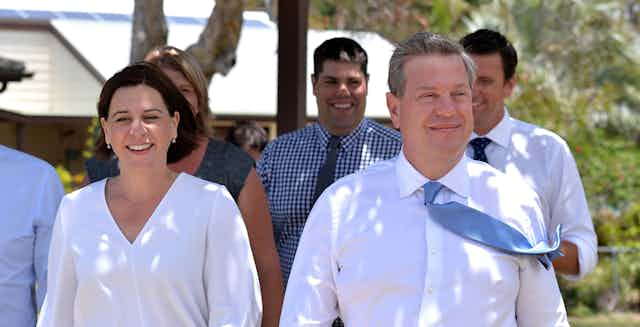There can be no doubt that in matters political Queensland is different from the rest of Australia.
It is the only state that has a single house of parliament. It is the only state that has a single council for its capital city. It is the only state in which the Country (and later National) Party has been the dominant force on the non-Labor side of politics and, for a time in the 1980s, held government in its own right.
The rhythm of Queensland politics has been for one party to hold power for long stretches of time. Labor was in government from 1932 to 1957, losing government that year as the Labor Party split. The Country Party held power, first in coalition with the Liberals and then in its own right, from 1957 to 1989. Subsequently, Labor was in office, except for a short time in 1996, from 1989 to 2012.
Queensland voters, at least in recent times, also seem to be more volatile in their voting habits, perhaps more resembling Canada than other parts of Australia. In Sydney, for example, there are electorates that are so rusted on to a political party that electing a member from another party is unthinkable.
Read more: Queensland result, while decided on state issues, adds to Turnbull's burdens
This does not appear to be the case in Queensland, including Brisbane. In 2012, the Liberal National Party (LNP), led by Campbell Newman, won a stunning victory, claiming 44 seats with swings as high as 21%. In other states, many of these seats would be rusted-on Labor.
Given Queensland’s electoral history, one would have expected that the 2012 election would be the prelude to an extended term of LNP government. Yet, in 2015, the LNP lost 34 seats and government. As an example, the seat of Ipswich, which had swung some 20% to the LNP in 2012, had almost an exact same swing to Labor in 2015.
Perhaps the most extraordinary thing about the 2017 election has been the way in which Brisbane has become almost exclusively Labor. The LNP holds fewer than half-a-dozen seats. While this may be in part a consequence of how One Nation allocated its preferences, this only confirms the weakness of the LNP in Brisbane.
The birth of the LNP
The Queensland LNP came into being in 2008 with the marriage of the Queensland divisions of the National Party and the Liberal Party. This was at a time when the non-Labor side of politics had, except for a short period mentioned above, been out of power for nearly 20 years.
Although the Nationals were clearly the senior partner, the president of the new party acquired full voting rights with the federal Liberals. Even more curious is the fact that those from the “Liberal” side of the party have tended to dominate the leadership.
In other states, where the Liberals are the senior party, as at the Commonwealth level, the two parties have favoured coalition rather than amalgamation (cohabitation rather than marriage).
That the Nationals and the Liberals should have come together at all seems in some ways astonishing, given the cavalier way in which Joh Bjelke-Petersen treated the Liberals back in the 1980s.
In days gone by, the Queensland Liberals were quite unlike other Liberal parties in Australia. Being always the junior member of the partnership meant that the party was much more of a “liberal” party, based in urban Brisbane.
Populism and conservatism were the property of the National Party. It is worth recalling that it was the Liberal Party that disendorsed Pauline Hanson as a candidate in the 1996 election.
It may have made good sense in electoral terms for the National Party and the Liberal Party to amalgamate in 2008. It appears to have delivered in 2012. But it has failed to deliver a second time. I think that there are some good reasons for this.
Read more: Queensland election: One Nation dominates Twitter debate in the final weeks
The amalgamation followed the logic that a unified anti-Labor Party would be more likely to defeat Labor. However, this decision was made at a time when a political reconfiguration was occurring in which the old right-left, business-unions divisions were becoming less important.
In its place has been the emergence of a new politics based around more symbolic matters and in which progressives increasingly find themselves at odds with conservatives on a whole range of matters, from the environment to same-sex marriage.
The LNP tethered together progressives and conservatives. In Newman it had a leader who was a good liberal reformer, rather reminiscent of Nick Greiner in New South Wales. Perhaps Newman should have studied what happened to Greiner, who barely scraped back into power in the 1991 NSW election.
Moreover, populism has never really gone away in Queensland. Labor Premier Peter Beattie had a touch of Joh about him.
Uneasy bedfellows
What I am suggesting is that the creation of the LNP was backward- rather than forward-looking. In a state in which populism is an established tradition, it was always going to be difficult to get the conservative and progressive horses to run together in the same direction.
Bob Katter and Hanson have been beneficiaries of the inability of the LNP to express its inner populism. Remember that John Howard neutralised Hanson by stealing her thunder. Cohabitation was a hindrance to liberals and conservatives alike.
But the primary beneficiary of this state of affairs has been the Labor Party. I think it can be argued that the too rigid nature of the LNP has led to a fracturing of the non-Labor side of politics. If the Liberals and Nationals had simply continued to cohabit they may have been able to have the flexibility required for electoral success.

